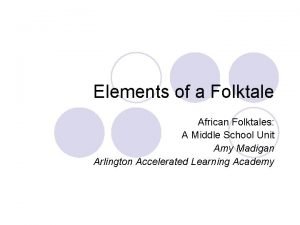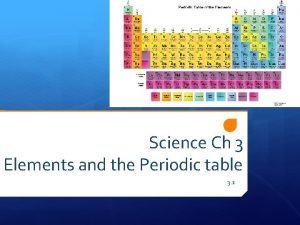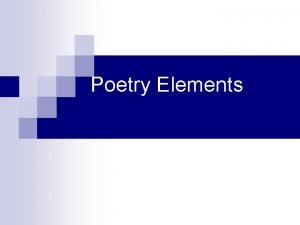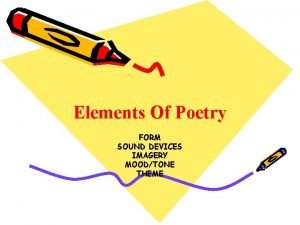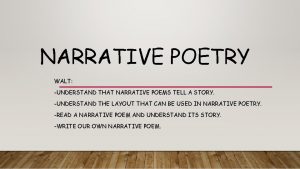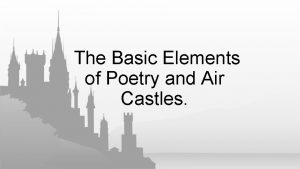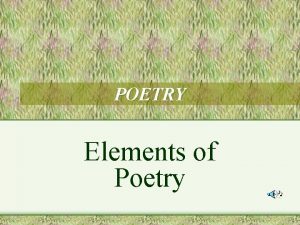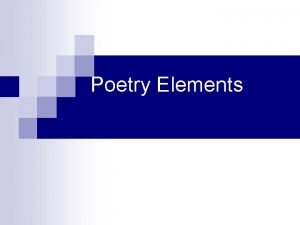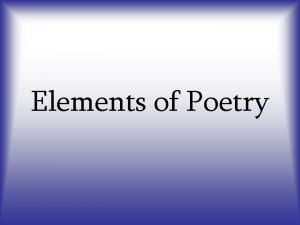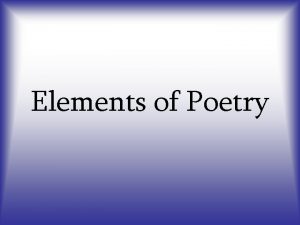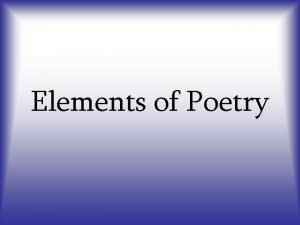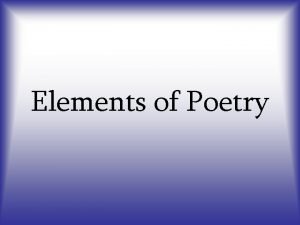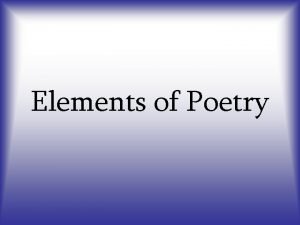Elements of Poetry What is Poetry Poetry is










- Slides: 10

Elements of Poetry

What is Poetry? • Poetry is the most compact form of literature. • A poem packs all kinds of ideas, feelings, and sounds into a few carefully chosen words. • The words, sounds, and form all work together to create the total effect.

Understanding Poetry FORM -the way a poem looks LINES -what poetry is written in, which may or may not be in full sentences STANZAS -when the lines are separated into groups *Poets chose the arrangements of words and lines deliberately. The form of a poem can add to its’ meaning.

Examples… Form Because I could not stop for Death. He kindly stopped for me. The Carriage held but just ourselves. And Immortality- Groups of 4 lines. We slowly drove-He knew no haste And I had put away My labor and leisure too For His Civility 2 Stanzas

Understanding Poetry continued… SOUND -poems are meant to be read aloud RHYME -words that end with the same sound rhyme RHYTHM -the “beat” of a poem -the part (s) of the poem that are more or less emphasized -poems without a regular rhythm are called free verse REPETITION -repeating certain sounds, words, or phrases gives more emphasis or feeling.

More Examples… • Rhyme: One if by land, two is by sea; And I on the opposite shore will be. • Rhythm: But ah, my foes, and oh, my friends It gives a lovely light (The “O” and “I” sounds are stressed) • Repetition: Once upon a midnight dreary, while I pondered, weak and weary (The “W”and “RY”sounds are repeated)

Elements of Poetry continued again… IMAGERY -using words and phrases that appeal to the five senses. FIGURATIVE LANGUAGE -words and phrases that help the reader to picture ordinary things in new ways -figures of speech include: simile, metaphor, and personification THEME -the message that the poem conveys

Even More Examples… • Simile: The willows music is like a soprano (Compares the music to a soprano (singer)) • Metaphor: The fog comes on little cat feet (Describes the fog as if it were a cat) • Personification: Summer grass aches and whispers (Compares grass to a human with feelings)

Strategies for Reading Poetry 1. Preview the poem -notice the form, shape, length, lines, and stanzas 2. Read the poem aloud -pause at the end of complete thoughts and look for punctuation marks 3. Visualize the images -picture the images and comparisons 4. Think about words and phrases -wonder why certain words stand out

Strategies for Reading Poetry continued… 5. Try to figure out theme -ask yourself, “what is the message and point of this poem? ” 6. Let your understanding grow -realize what your first impressions of the poem are and reread to find deeper meaning 7. Allow yourself to enjoy poetry -realize what feelings you have after you read the poem and make connections.
 Common elements of folktales
Common elements of folktales Overhead allocation
Overhead allocation The elements of a folktale
The elements of a folktale Atomic elements vs molecular elements
Atomic elements vs molecular elements Http //elements.wlonk.com/elements table.htm
Http //elements.wlonk.com/elements table.htm Use of face, body and voice to portray character
Use of face, body and voice to portray character Nnn poem lyrics
Nnn poem lyrics Sound elements in poetry
Sound elements in poetry How to write a narrative poem
How to write a narrative poem Air castle by juan f. salazar
Air castle by juan f. salazar Elements of poetry rhyme
Elements of poetry rhyme


